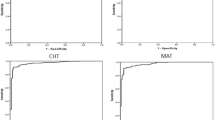Abstract
A comparison was made of the indirect immunofluorescence assay and microagglutination in the diagnosis of infections caused byLegionella pneumophila serogroup 1. Control sera consisted of 709 sera from patients without pneumonia and 99 sera from patients with mycoplasma or clamydia infection. The 468 test sera were from 51 patients with serologically confirmed or suspectedLegionella pneumophila serogroup 1 infection, and from 230 patients with pneumonia of unknown aetiology. There was good agreement between the results of the two methods for detection of antibodies toLegionella pneumophila serogroup 1. However, contrary to what is currently reported in the literature, microagglutination was the more sensitive method in this study, especially if the first serum samples were compared. The detection of IgM by microagglutination probably explains this increased sensitivity.
Similar content being viewed by others
References
Jones, G. L., Hebert, G. A. (ed.: Legionnaires: the disease, the bacterium and methodology. Center for Disease Control, Atlanta, 1979.
Bornstein, N., Marmet, D., Fleurette, J.: Isolement et caractérisation des trois premières souches deLegionella pneumophila isolées en France. Annales de Microbiologie 1981, 132 B: 405–417.
Edelstein, P. H., Meyer, R. D., Finegold, S. M.: Laboratory diagnosis of Legionnaires'disease. American Review of Respiratory Disease 1980, 121: 317–327.
Taylor, A. G., Harrison, T. G., Dighero, M. W., Bladstreet, C. M. P.: False positive reactions in the indirect fluorescent antibody test for Legionnaires'disease eliminated by use of formolised yolk sac antigen. Annals of Internal Medecine 1979, 90:686–689.
Farshy, C. E., Klein, G. C., Feeley, J. C.: Detection of antibodies by a microagglutination test. In: Jones, G. L., Hebert, G. A. (ed.): Legionnaires. The disease, the bacterium and methodology. Center for Disease Control, Atlanta, 1978, p.112–115.
Farshy, C. E., Klein, G. C., Feeley, J. C.: Detection of antibodies to Legionnaires'disease organism by microagglutination and micro-enzyme linked immunosorbent assay tests. Journal of Clinical Microbiology 1978, 7: 327–331.
Klein, G. C., Jones, W. L., Feeley, J. C.: Upper limit of normal titer for detection of antibodies toLegionella pneumophila by the microagglutination test. Journal of Clinical Microbiology 1979, 10: 754–755.
Alton, G. G., Jones, L. M.: Laboratory techniques in brucellosis. World Health Organization, Geneva, 1967, p. 112.
Basich, J. E., Resnick, A., Fink, J. N.: Hypersensitivity pneumonitis and Legionnaires'disease. American Review of Respiratory Disease 1980, 121: 885–887.
Collins, M. T., Cho, S. N., Reif, J. S.: Prevalence of antibodies toLegionella pneumophila in animal populations. Journal of Clinical Microbiology 1982, 15: 130–136.
Klein, G. C.: Cross reaction toLegionella pneumophila antigen in sera with elevated titers toPseudomonas pseudomallei. Journal of Clinical Microbiology 1980, 11: 27–29.
Smalley, D. L., Ourth, D. D.: Comparison of the microagglutination test with bactericidal response toLegionella pneumophila (Legionnaires'disease bacterium). Journal of Clinical Microbiology 1980, 11: 200–201.
Smalley, D. L., Ourth, D. D.: Seroepidemiology ofLegionella pneumophila. A study of adults from Memphis, Tennessee, USA. American Journal of Clinical Pathology 1981, 75: 201–203.
Taylor, A. G., Harrison, T. G.: Timing of antibody response in Legionnaires'disease. Lancet 1979, ii: 597.
Taylor, A. G., Harrison, T. G.: Formolised yolk sac antigen in early diagnosis of legionnaires disease caused byLegionella pneumophila serogroup 1. Lancet 1981, ii: 591.
Farshy, C. E., Cruce, D. D., Klein, G. C., Wilkinson, H. W., Feeley, J. C.: Immunoglobulin specificity of the microagglutination test for the Legionnaires'disease bacterium. Annals of Internal Medecine 1979, 90: 690.
Nagington, J., Wreghitt, T. G., Tobin, J. O. H., Macrae, A. D.: The antibody response in Legionnaires'disease. Journal of Hygiene Cambridge 1979, 83: 377–381.
Harrison, T. G., Taylor, T. G.: A rapid microagglutination test for the diagnosis ofLegionella pneumophila (serogroup 1) infection. Journal of Clinical Pathology 1982, 35: 1028–1031.
Tram, C., Mailloux, M., Mollaret, H. H.: Contribution a l'étude de la nature des relations entre leptospiroses et legionelloses. Médecine et Maladies infectieuses 1981, 11: 594–596.
Author information
Authors and Affiliations
Rights and permissions
About this article
Cite this article
Bornstein, N., Fleurette, J. Comparison of microagglutination with the indirect immunofluorescence assay for the diagnosis of infection withLegionella pneumophila serogroup 1. Eur. J, Clin. Microbiol. 2, 335–339 (1983). https://doi.org/10.1007/BF02019463
Issue Date:
DOI: https://doi.org/10.1007/BF02019463




